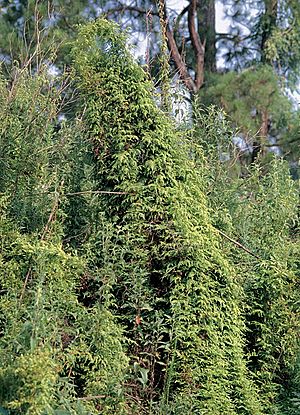Vine-like fern facts for kids
Quick facts for kids Vine-like fern |
|
|---|---|
 |
|
| Scientific classification | |
| Genus: |
Lygodium
|
| Species: |
japonicum
|
Lygodium japonicum, also known as the Japanese climbing fern or vine-like fern, is a type of fern. It naturally grows in eastern Asia, including places like Taiwan, Japan, Korea, southeastern Asia, and India. You can also find it in eastern Australia. This fern has been brought to the southeastern United States and Puerto Rico, where it is now an introduced species.
Contents
What Does It Look Like?
This fern has a stem that creeps along the ground. From this stem, very long leaves grow. Some of these leaves can be longer than 30 meters (about 100 feet)! The main stems of these leaves are called rachises. They are like vines and can climb up other plants.
What might look like individual leaves growing from the climbing rachis are actually smaller parts of the main leaf, called leaflets. There are two kinds of leaflets:
- Sterile leaflets: These are shaped like a spear (lance-shaped). They do not produce spores.
- Fertile leaflets: These are more detailed and have fringed edges. They have tiny cases called sporangia along their edges. These sporangia hold the fern's spores.
The fern reproduces in two ways. It makes new plants from spores, which are like tiny seeds. It also spreads underground using special stems called rhizomes.
Where It Grows and Why It's a Problem
The Japanese climbing fern was first seen growing in Georgia in 1903. In the southeastern United States, it is now considered an invasive weed. This means it grows quickly and can harm the environment and economy.
This fern likes to grow in wet, swampy areas, especially where the ground has been disturbed. If you see plants like the small-spike false nettle (Boehmeria cylindrica) or royal fern (Osmunda spectabilis), the Japanese climbing fern might be nearby.
One big problem with this fern is during controlled burns, which are fires set on purpose to manage forests. The fern can act like a "fuel ladder". This means it helps the fire climb from the ground up into the tops of trees, which can destroy them. Even after a fire, the fern can grow back very quickly, so fire doesn't control it well.
Naming the Fern
The second part of the fern's scientific name, japonicum, means 'from Japan' in Latin.
A scientist named Carl Peter Thunberg first described this fern in 1784. Later, in 1802, another scientist named Olof Swartz gave it its current scientific name, Lygodium japonicum.
Images for kids


